Discover the allure of mid-century modern kitchen design, a style that combines retro charm with contemporary finesse. This article delves into the unique features that make mid-century modern kitchens a coveted choice for homeowners seeking a blend of nostalgia and modernity in their culinary spaces.
Elegant Mid Century Modern Kitchen Lighting Fixtures

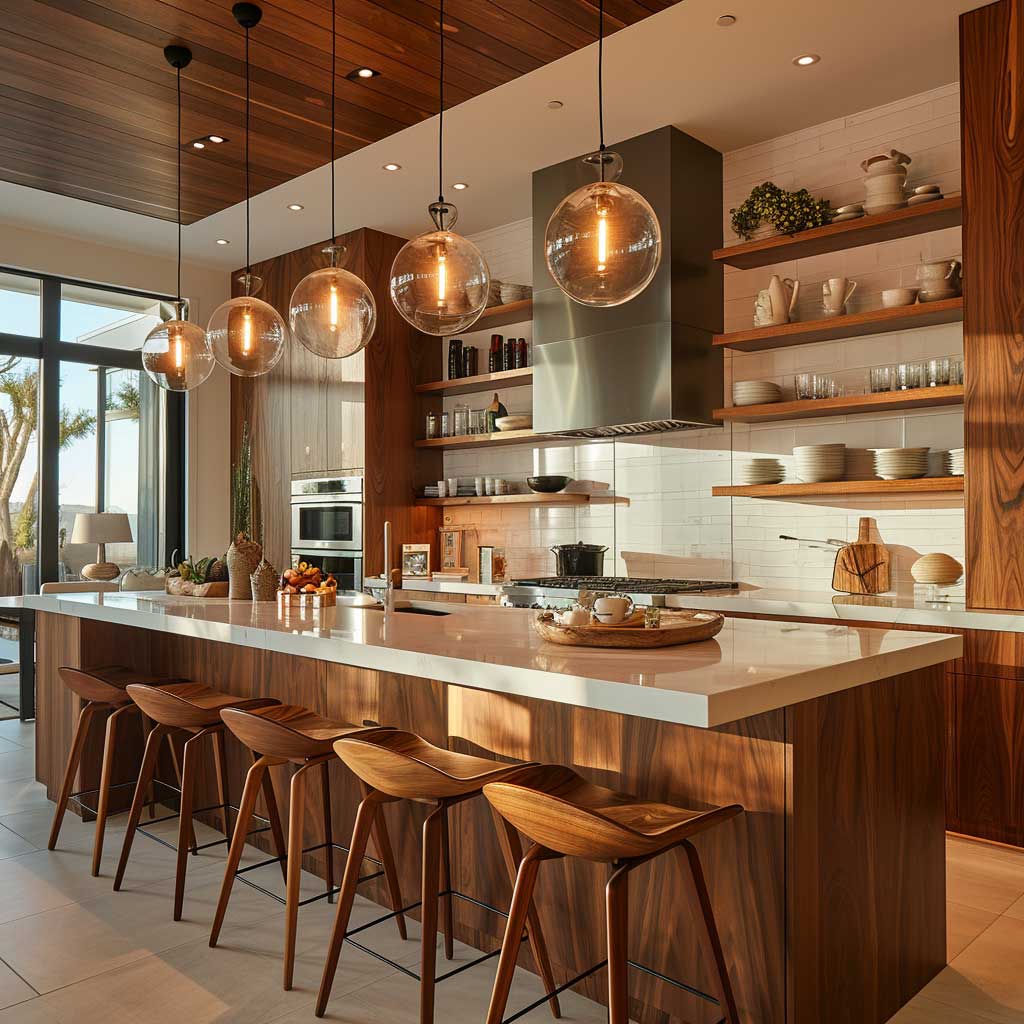
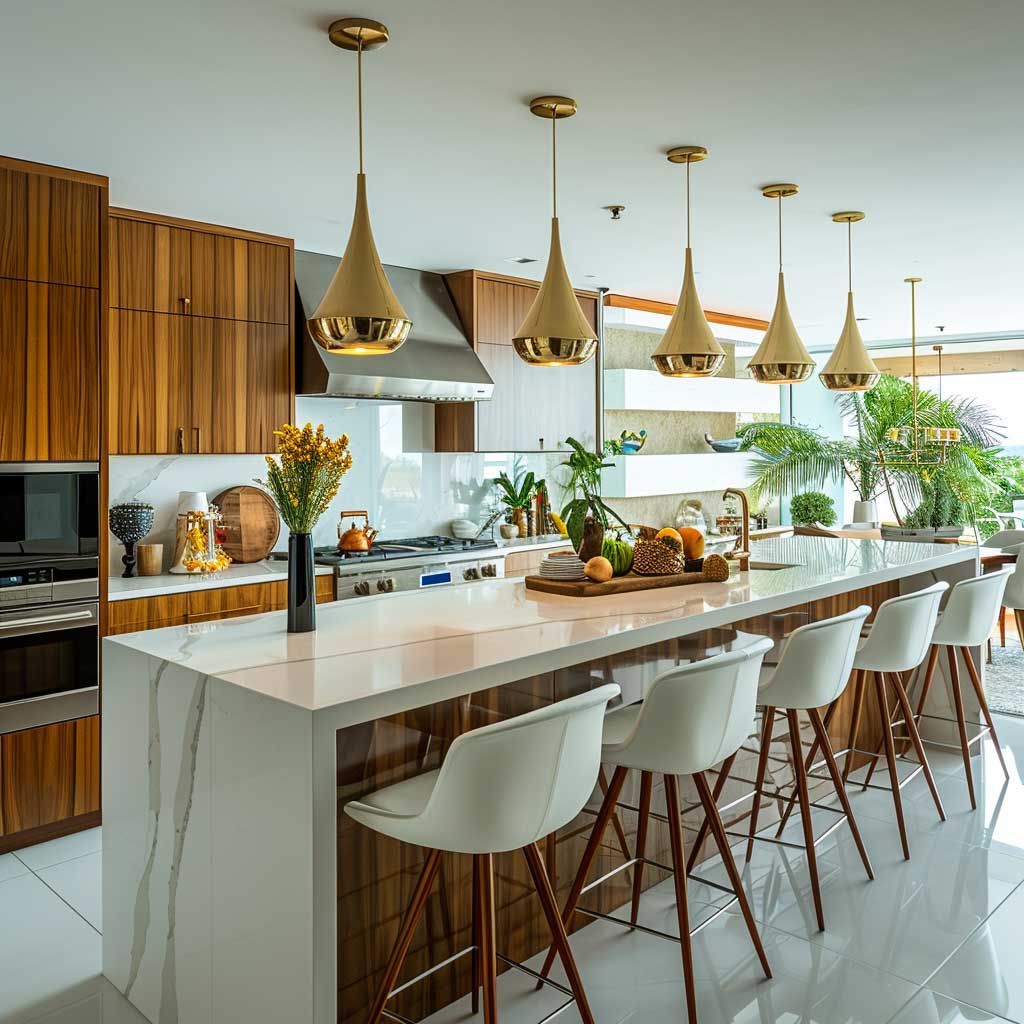

Mid-century modern kitchen design is distinguished by its clean lines, functional simplicity, and thoughtful use of both color and form. Central to this design philosophy is the use of lighting, which in mid-century modern kitchens, is not just a practical necessity but a key design element. The era’s lighting fixtures are renowned for their elegant designs, which blend art and functionality, casting both light and style throughout the space.
The hallmark of these lighting fixtures is their geometric shapes and bold, yet unobtrusive designs. Often crafted from a combination of traditional materials like glass and wood with modern metals, they make a statement without overpowering the room. Pendant lights, in particular, are a popular choice in mid-century modern kitchens. These fixtures, often placed over kitchen islands or dining areas, provide concentrated lighting and are available in various shapes like globes, cones, or cylinders. Their designs range from sleek and simple to intricate and sculptural, allowing for personal expression within the space.
Another feature of mid-century modern kitchen lighting is the thoughtful placement and layering of different light sources. This design approach considers how each lighting fixture contributes to the overall ambiance of the kitchen. For instance, recessed ceiling lights offer general illumination, while under-cabinet lights provide task lighting for countertops. This layering creates a well-lit yet cozy space, essential in a room where functionality is as important as aesthetics.
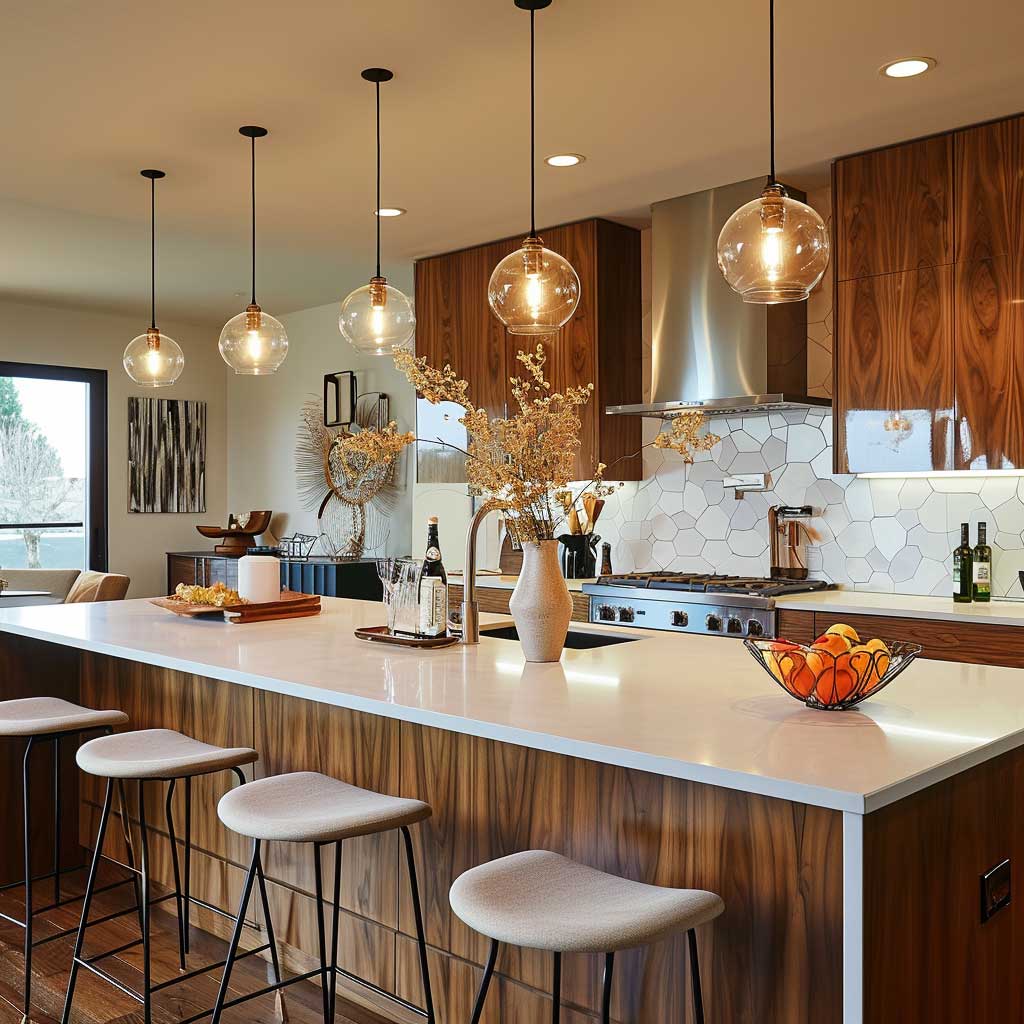

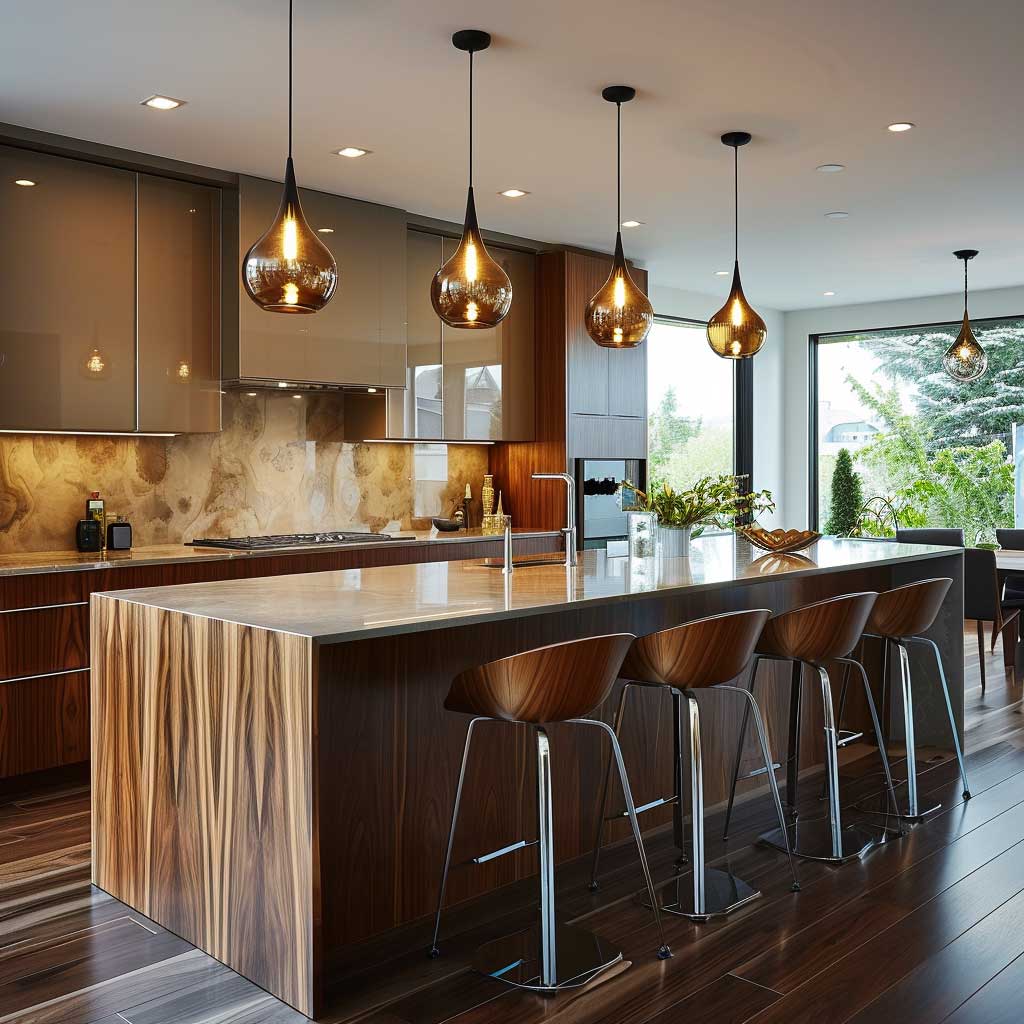
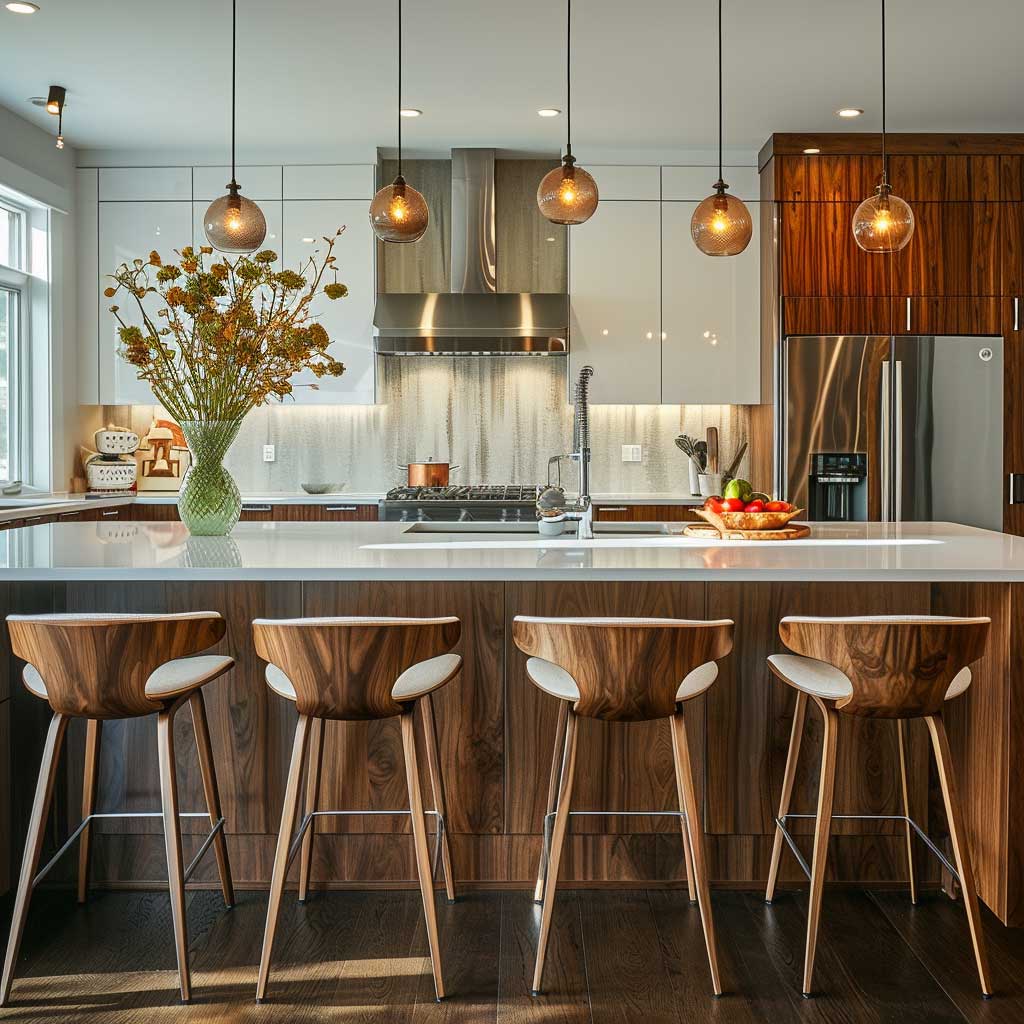
The choice of color and material in lighting fixtures also plays a significant role in mid-century modern design. While the era was known for its bold use of color, lighting fixtures often feature neutral tones or warm metallic finishes like brass or copper. These choices help in creating a warm, inviting atmosphere, balancing the cooler tones of typical mid-century modern color palettes.
In addition to their aesthetic appeal, mid-century modern lighting fixtures are also valued for their quality and craftsmanship. During this era, designers and manufacturers paid close attention to detail, resulting in fixtures that were not only visually appealing but also durable and well-made. This emphasis on quality means that many original mid-century modern fixtures are still in use today, prized by homeowners and collectors alike.
Functionality is another key aspect of these fixtures. The mid-century movement was all about making design accessible and practical. Lighting fixtures from this era often feature adjustable components, allowing homeowners to direct light exactly where it’s needed. This flexibility is particularly useful in the kitchen, where task lighting is essential.
The influence of mid-century modern design extends beyond the fixtures themselves. It also impacts the kitchen’s overall layout and architecture. For instance, skylights and large windows are common in mid-century homes, complementing the artificial lighting with ample natural light. This integration of indoor and outdoor elements is a hallmark of the style, reflecting its emphasis on harmony and connection with nature.
In summary, lighting fixtures in mid-century modern kitchen design are much more than mere sources of illumination. They are integral to the aesthetic of the space, representing the era’s dedication to blending form and function. Their elegant designs, thoughtful placement, and quality construction contribute significantly to the timeless appeal of mid-century modern kitchens, making them a beloved design choice even in contemporary homes.
Chic Mid Century Modern Kitchen Color Schemes
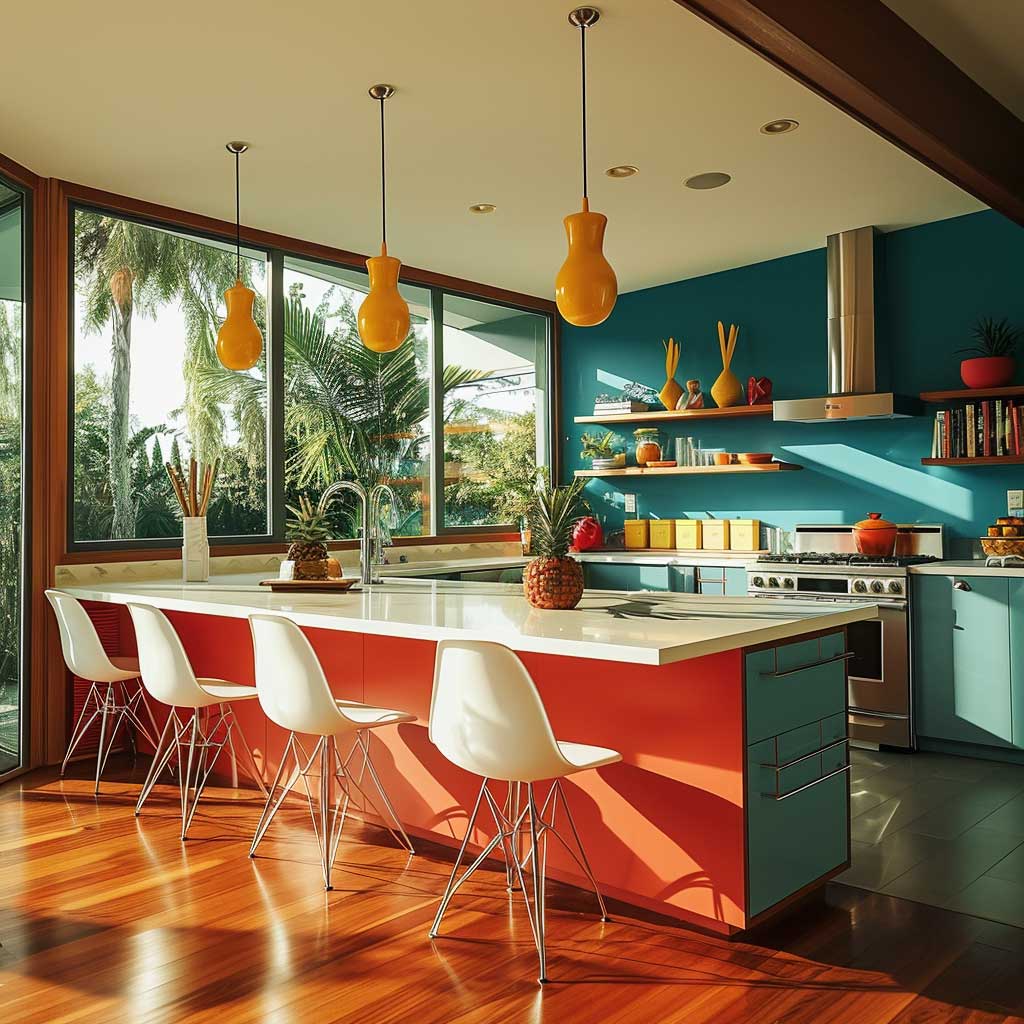
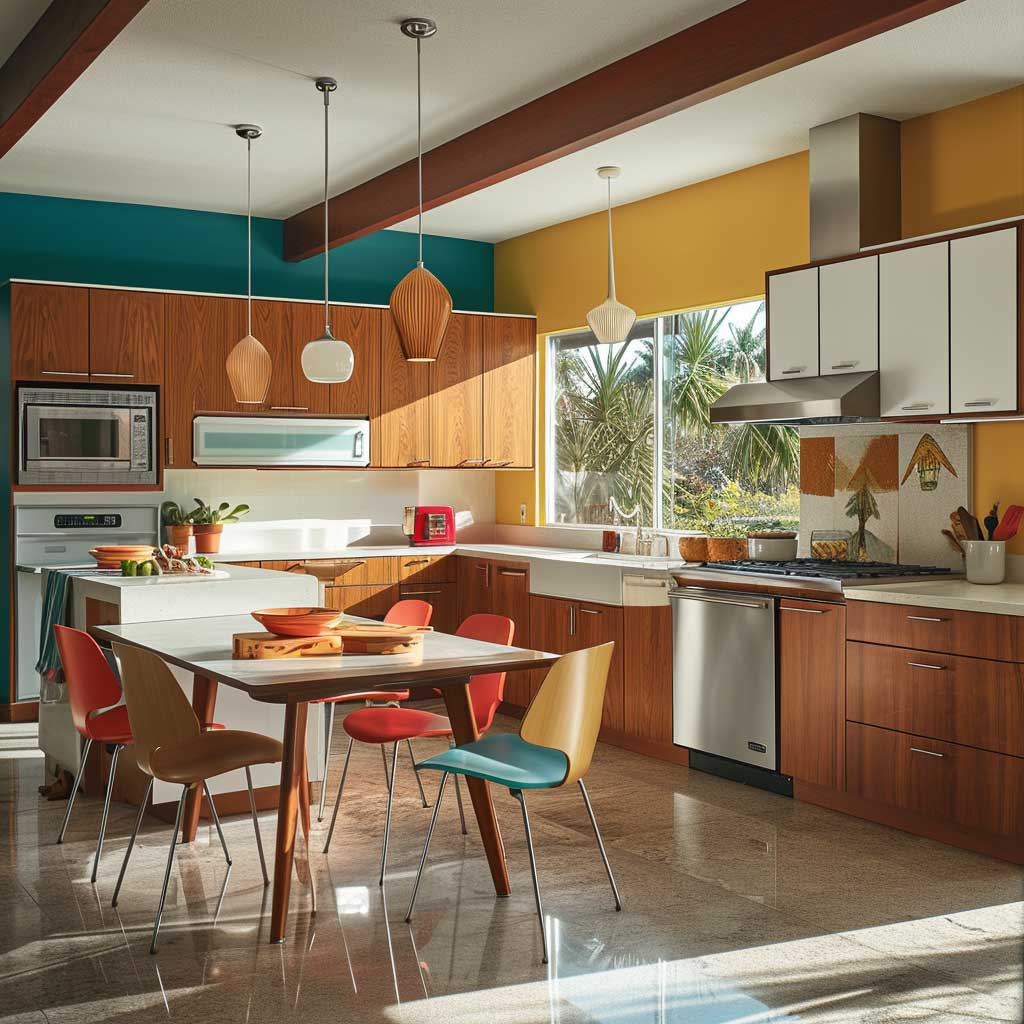
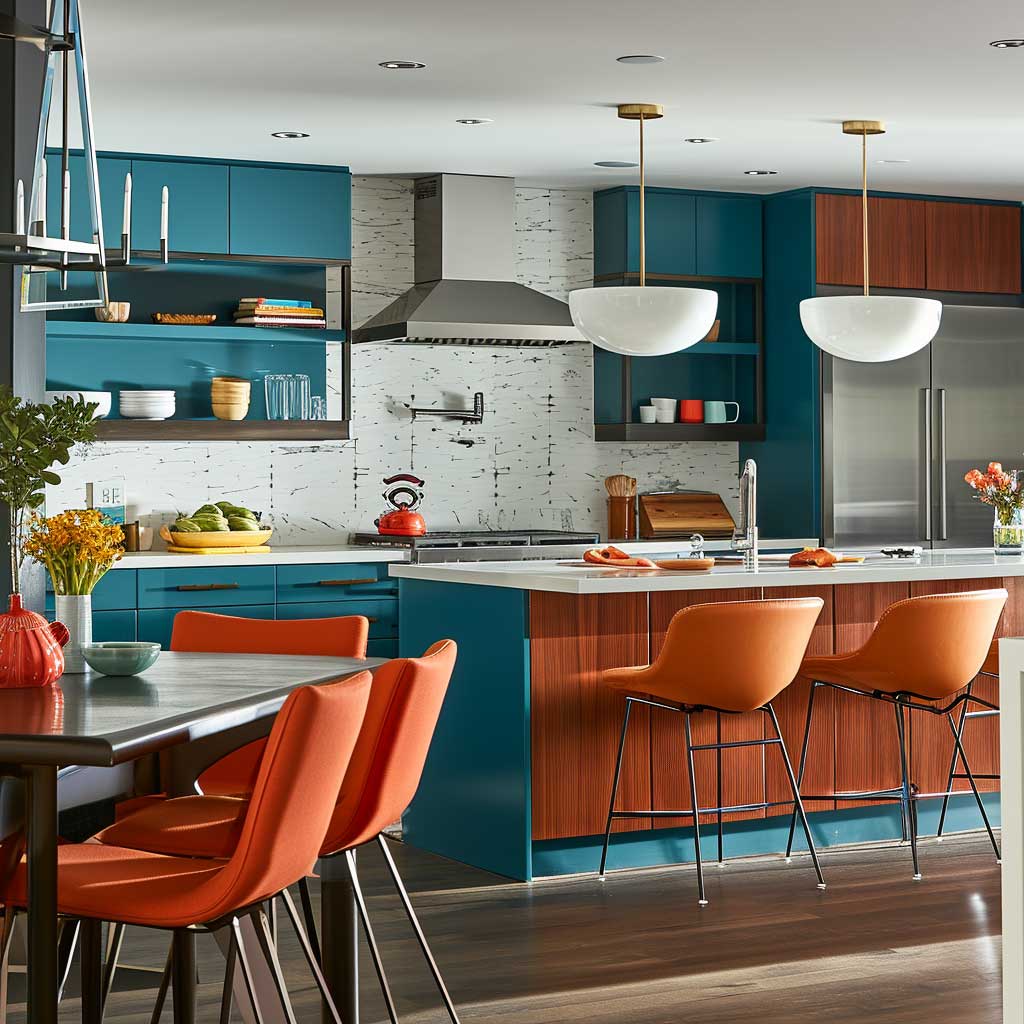
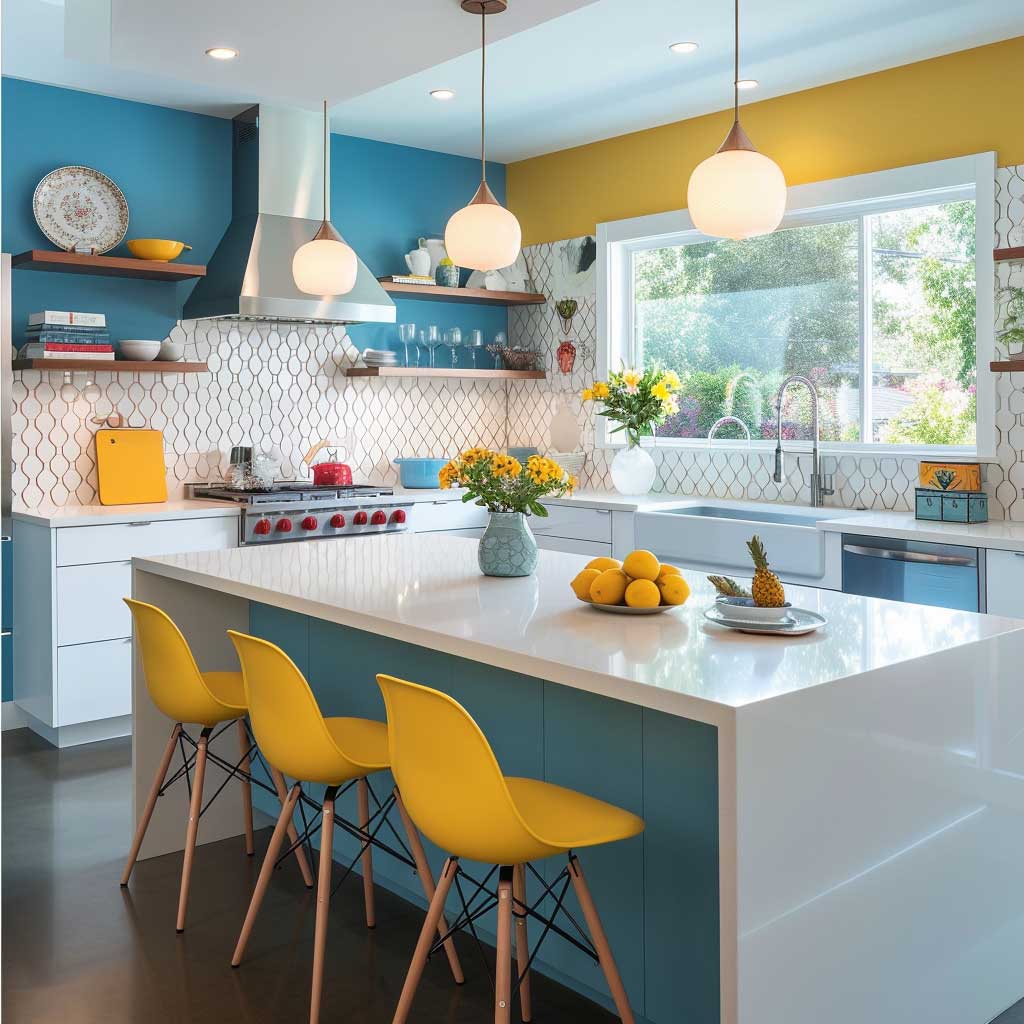
Mid-century modern kitchen design, celebrated for its clean lines, functional layout, and attention to detail, is equally notable for its distinctive use of color. The color schemes in these kitchens are a thoughtful blend of bold accents and soothing neutrals, creating a space that is both vibrant and calming. This unique approach to color encapsulates the spirit of the mid-century era, which sought to break free from traditional design norms and embrace a more adventurous aesthetic.
Central to these color schemes is the balance between bold and muted tones. Vibrant colors like turquoise, avocado green, or tangerine were popular in mid-century modern design, reflecting the optimism and energy of the post-war era. These lively hues often appear as accents – on a feature wall, in backsplash tiles, or on kitchen appliances – providing a pop of color that enlivens the space.
In contrast, these vivid shades are grounded by more subdued, neutral tones such as white, gray, or wood finishes. These neutrals form the base of the kitchen’s color palette, covering large surface areas like walls, countertops, and cabinetry. This juxtaposition not only highlights the bolder colors but also maintains a sense of calm and order in the space. It’s a testament to the era’s design ethos, which valued both excitement and practicality.
The integration of these colors is further enhanced by the use of natural materials, a key element in mid-century modern design. Wood, in particular, is a common feature in these kitchens, often used for cabinetry or as an accent material. Its natural hues and textures add warmth and depth to the space, balancing the cooler elements of the color scheme.
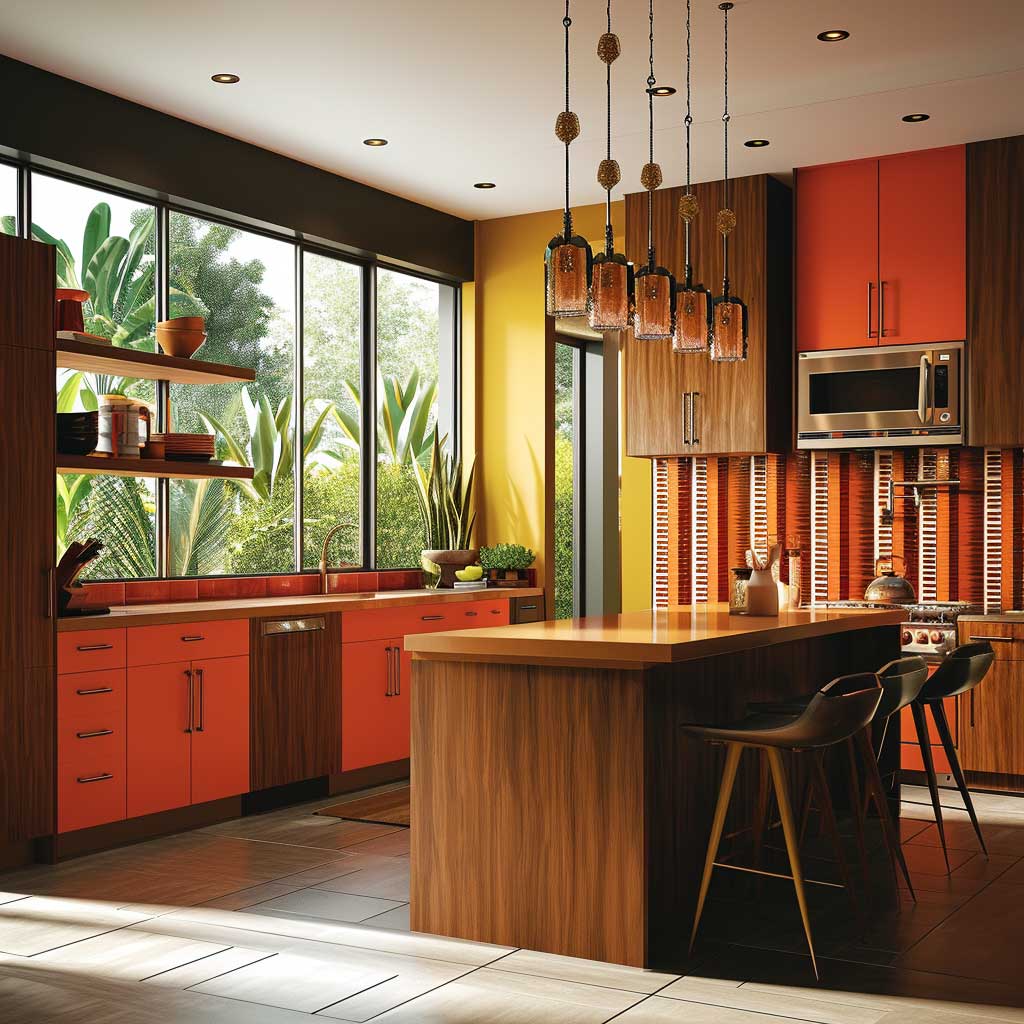
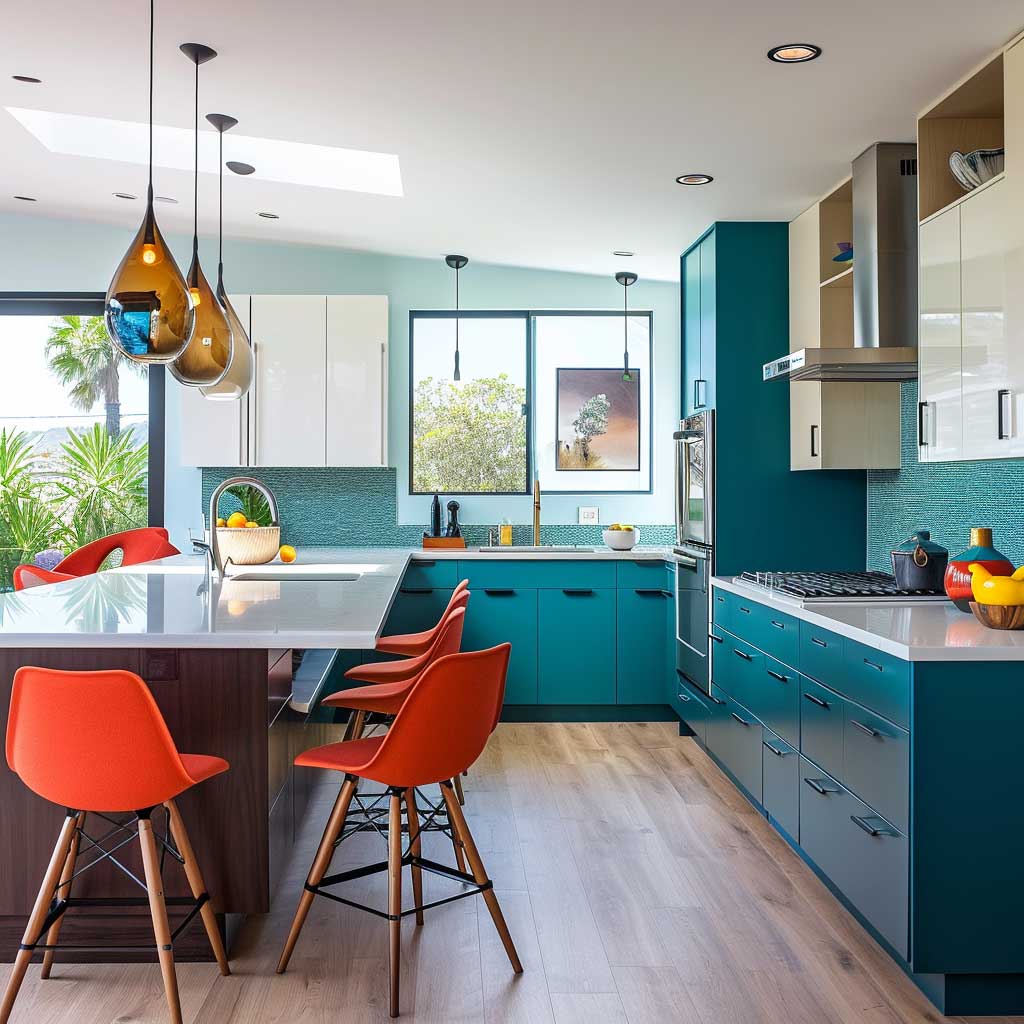


Textiles and accessories in the kitchen also play a role in the color scheme. Patterned curtains, vibrant rugs, or colorful chairs can introduce additional hues, contributing to the dynamic yet cohesive look. These elements provide an opportunity for homeowners to personalize their space and adapt it to changing trends or personal preferences.
Lighting, too, affects the perception of color in the kitchen. The mid-century modern style often features large windows and skylights, allowing natural light to flood the space and highlight the color scheme. In the evening, strategically placed artificial lighting can enhance the colors, creating a warm and inviting ambiance.
The choice of color in mid-century modern kitchens also reflects a broader cultural context. The era was marked by a sense of optimism and a forward-looking attitude, which is mirrored in the bold, cheerful colors. At the same time, the grounding neutrals speak to a desire for simplicity and understated elegance, values that were equally important during this time.
In conclusion, the color schemes in mid-century modern kitchens are a vital component of their design. By skillfully balancing bold accents with soothing neutrals and integrating natural materials, these kitchens achieve a look that is both lively and harmonious. This approach to color not only reflects the design trends of the mid-century era but also contributes to the timeless appeal of these spaces, making them as relevant today as they were in the past.
Seamless Integration of Mid Century Modern Kitchen Appliances




The essence of mid-century modern kitchen design lies in its ability to blend functionality with aesthetic appeal, a concept best exemplified in the seamless integration of appliances. This design philosophy emerged in the mid-20th century, a period marked by a surge in technological advancements and a shift towards a more streamlined, minimalist aesthetic in home design.
At the heart of this approach is the integration of kitchen appliances in a way that complements the overall design theme. Unlike traditional kitchens where appliances stand out, mid-century modern kitchens are characterized by appliances that blend into the surroundings. This integration is achieved through the use of cabinetry panels that cover refrigerators and dishwashers, creating a unified and uninterrupted visual flow.
The color palette plays a crucial role in this integration. Mid-century modern designs often feature a balance of neutral tones and bold colors. Appliances in stainless steel or those with matte finishes in blacks, whites, or grays, are popular choices. They provide a sleek, unobtrusive look that aligns with the clean lines and uncluttered spaces of the design style.
Another aspect is the layout. The mid-century modern kitchen is all about efficiency and ease of movement. Appliances are arranged for optimal functionality, often following the classic work triangle between the stove, sink, and refrigerator. This layout ensures that everything is within easy reach, enhancing the usability of the space.

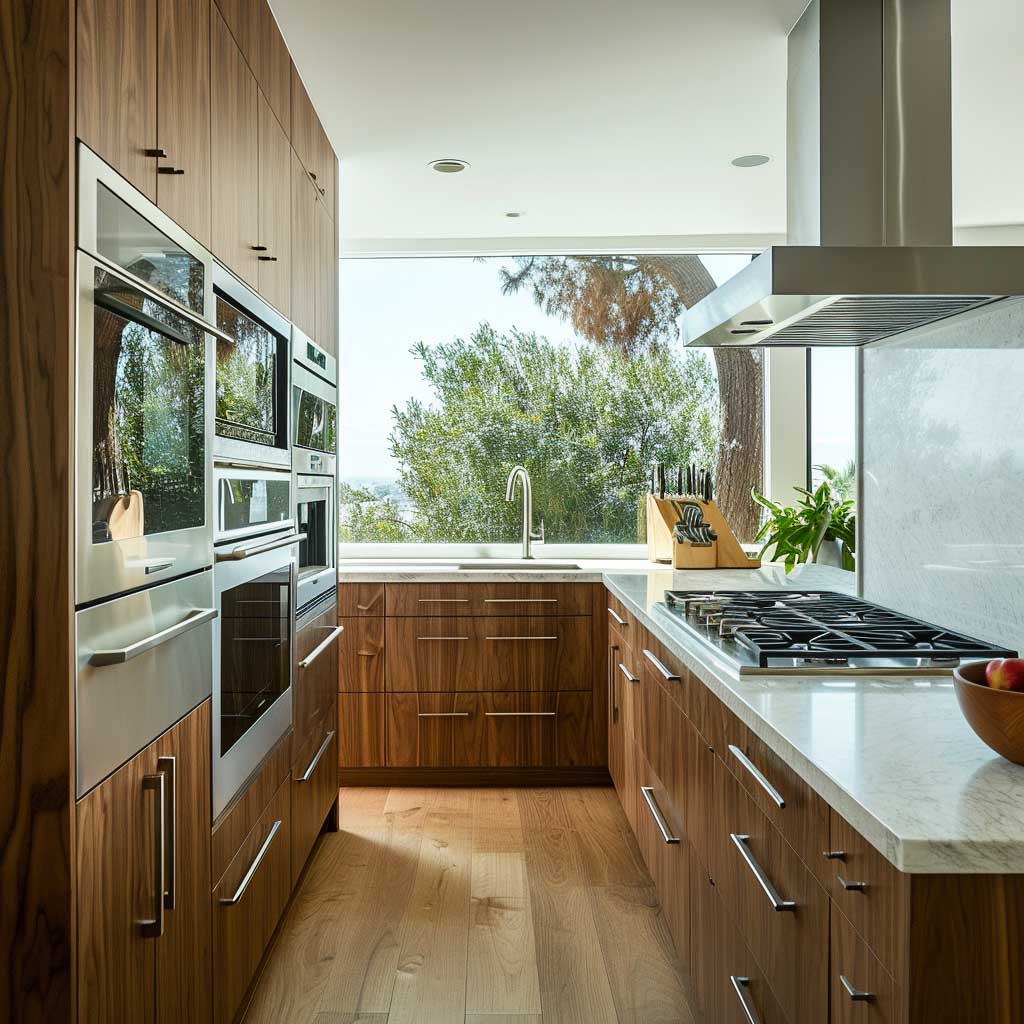


The choice of appliances also reflects the era’s fascination with innovation. Features like induction cooktops, convection ovens, and smart refrigerators resonate with the mid-century modern ethos of embracing new technologies. These appliances not only offer convenience but also contribute to the sleek, futuristic look characteristic of the style.
Lighting, too, is a critical component. In mid-century modern kitchens, lighting is not just functional but also a design element. Under-cabinet lights, for instance, provide task lighting while accentuating the streamlined design of the cabinetry. Pendant lights over islands or dining areas add a touch of elegance and are often in shapes and colors that echo the mid-century aesthetic.
Furniture and accessories in the kitchen further enhance the seamless integration. Bar stools at the kitchen island, open shelving, and minimalist decor items are chosen to complement the appliances and cabinetry, creating a cohesive look. The use of natural materials like wood alongside metal and glass adds warmth and texture, balancing the modern elements.
Finally, the integration of indoor and outdoor spaces, a hallmark of mid-century architecture, is often reflected in the kitchen design. Large windows that let in natural light and offer views of nature help to soften the technological aspects of the appliances, creating a harmonious balance between the natural and the man-made.
In conclusion, the seamless integration of appliances in mid-century modern kitchen design is more than just an aesthetic choice. It is a reflection of the era’s values – a blend of functionality, innovation, and beauty. This approach creates kitchens that are not just places for cooking but are also central to the home’s overall design and feel, embodying the timeless appeal of mid-century modern style.
This exploration of mid-century modern kitchen design reveals how this style remains timeless and versatile. Emphasizing functionality, aesthetics, and a nod to the past, these kitchens offer a sanctuary that is both inviting and stylish. The distinctive features, from integrated appliances to unique lighting and color schemes, highlight why mid-century modern design continues to captivate and inspire.



















